Touch of Glass
Here we look at the history of Chesterfield's glassware industry over the years.
Whittington Glass
The earliest glassmaking business in Chesterfield was established at Whittington around 1704 by Richard Dixon.
The glasshouse initially made dark coloured glass bottles but soon began producing a wide range of decorative cut glass including dishes, drinking glasses and decanters.
The business was managed by the Dixon family for over a century. The last Whittington glass maker was John Dixon and the glasshouse appears to have ceased production shortly before his death in 1816.

Although, nothing survives of the glassworks today, it is most likely that the furnace was cone shaped. This was a common furnace design in the 18th century. This one (pictured above) at Catcliffe is one of the last surviving cone furnaces. The furnace and working area are located inside the cone. Air is drawn into the furnace through underground tunnels while the cone acts as a chimney to remove the fumes.
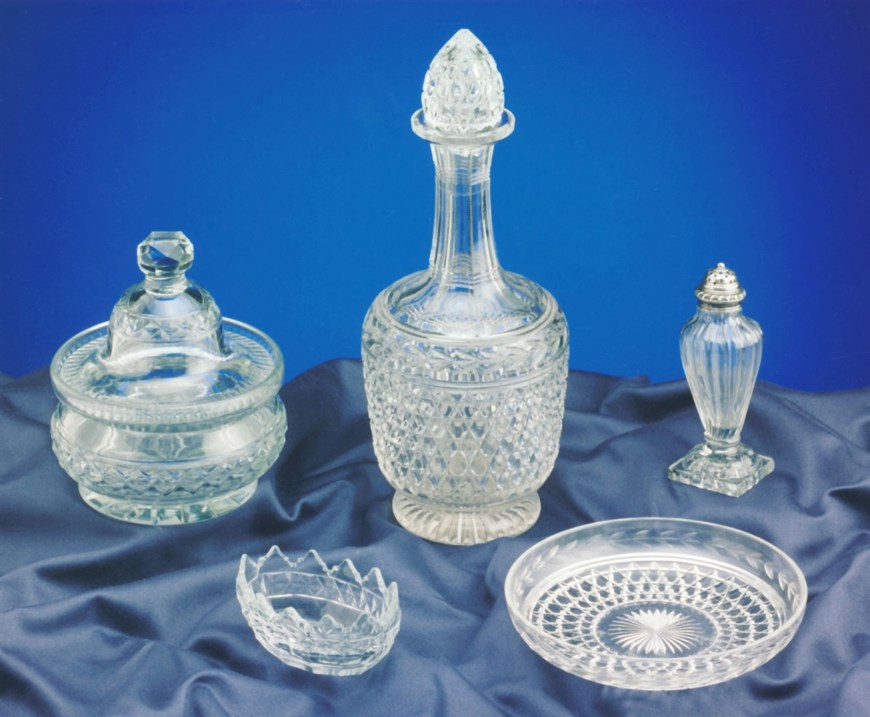
Pictured here are items of Whittington Glass. The 18th century saw great consumer demand for glassware and cut glass items were particularly fashionable. Whittington Glassworks supplied the Sitwells at nearby Renishaw Hall with numerous items including lamps, wine glasses, decanters and a chandelier.
The location of the glassworks at Whittington had the advantage of locally available coal and clay (to make fire pots in which the raw ingredients for the glass were melted). Coal, in particular, was extracted from the common which adjoined the Glasshouse. This land was owned by the Dixons and was also mined for ironstone.
John Dixon was the grand-nephew of the founder, Richard Dixon and he was the driving force behind the glassworks for around forty years. By 1813, a wealthy man, he purchased much of the land in the Manor of Whittington. His step-son, Henry, inherited this on John’s death along with the coal and ironstone mines on Glasshouse Common. The Glassworks did not continue and Henry lived the life of landed gentry. He is thought to have built Whittington Hall.
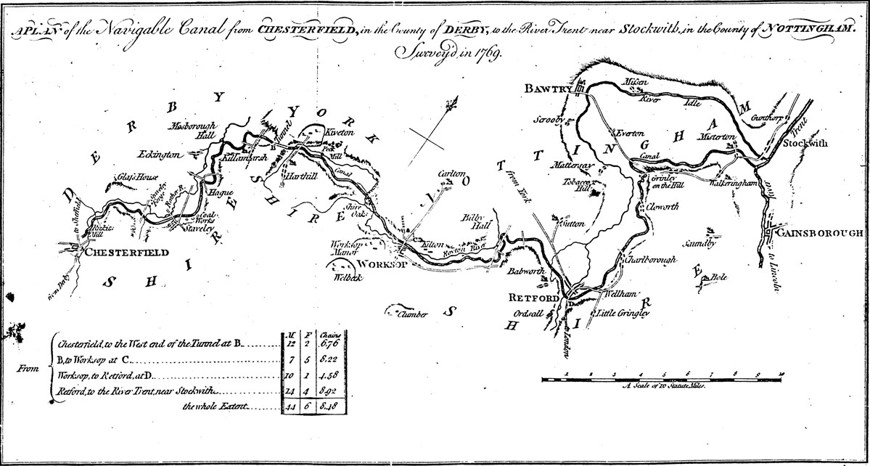
The building of Chesterfield Canal in 1777 was a great advantage for the Dixon’s glass making company. It proved a convenient and cheaper means of distributing goods and also enabled the Glasshouse to receive delivery of high quality sand from King’s Lynn for glassmaking rather than relying on local silicas.
Lighting the Way
Chesterfield Glassworks on Sheffield Road was established in 1923 by British Thomson-Houston (BT-H), an engineering company. The factory supplied glass for a wide variety of light bulbs, particularly Mazda Lamps, as well as tubes and rods for use in items such as radio valves and x-ray equipment.
The Glassworks expanded rapidly and investment in the latest glass working machines saw capacity double from around 450,000 bulbs per week in 1928 to up to 900,000 per week by 1937.
The Glassworks began making half pint glasses for the pub trade in the mid 1930s. This proved to be a successful line, however the Second World War meant that production focused on the manufacture of glass for the war effort. Special lamps for aircraft, tanks and signalling and cathode ray tubes for radar were made.

Initially all light bulbs at Chesterfield were blown by hand but production quickly became semi-automatic through investment in the latest glassmaking technology like this Westlake machine (pictured above). The hand blower’s skills were still needed though and all specialist lamps were made by hand.
By the 1930s BT-H had established a glass research laboratory at Chesterfield to help develop new products. Early work included the development of glass the use of cathode ray tubes to give high definition television reception.

Chesterfield Glassworks’ main lighting product was the glass for Mazda Lamps. In the 1930s, they made about half a million per week. The light bulbs themselves were assembled at BT-H’s factory in Rugby hence the ‘Made in Rugby’ stamp on the boxes.
At the beginning of the 1900s, BT-H had imported the bulk of its glass components from Europe. The First World War however brought supplies to a halt. As a result the company built its own glassworks. Chesterfield had a convenient location with good transport links and local coal supplies to make gas to power the furnaces.

Glass tubes and rods were a large part of Chesterfield Glassworks’ production. They were intended for a wide range of uses including radio valves, lighting, x-ray equipment and in the pharmaceutical industry.
Tableware, Tubes and TVs
The Dema trademark for domestic glassware was registered in 1947 and the following year tableware production began in earnest at Chesterfield. In 1950, the bulk of light bulb production was transferred by British Thomson-Houston (BT-H) to their new factory, Glass Bulbs Ltd, in Harworth and the Glassworks supplied specialist glass tubes, lamps and components.
The 1950s saw the production of cathode ray tubes for television sets. These were all hand blown and by 1954 the factory was making 11,000 tubes a week to meet growing demand. Success for the Dema product continued and by 1957 a separate company, Dema Glass Ltd, was established to market the growing range of glassware.
AEI Lamp and Lighting took over BT-H in 1955 and in 1961, in partnership with GEC, the Chesterfield factory became Glass Tubes and Components. The capacity of the Chesterfield Glassworks was increased to meet the growing need for glass tubes and to continue to supply Dema’s glasses.
After the takeover of BT-H by AEI Lamp and Lighting in 1955 and the formation of Glass Tubes and Components in 1961, Chesterfield Glassworks concentrated on the bulk manufacture of glass tubes and domestic tableware for Dema. The manufacture of valves and cathode ray tubes was discontinued at this time.
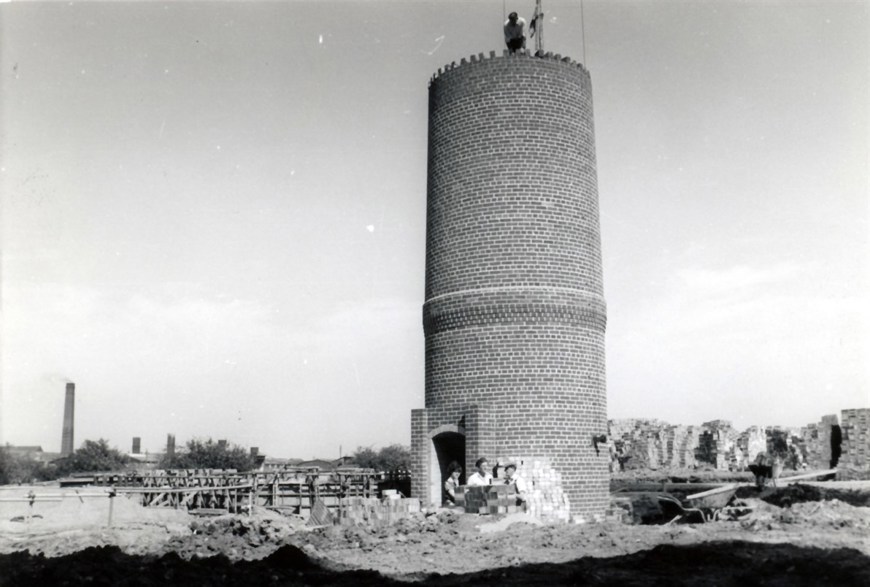
The 1960s saw expansion on the Chesterfield site. A larger furnace built in 1961 and the extension of the tube factory enabled the company to produce larger tubing at tighter tolerances for florescent lighting and the pharmaceutical industry. Pictured above is the new chimney being built.

Throughout the 1950s cathode ray tubes for televisions were made at Chesterfield. They were hand blown ranging from 9 inches to 16 inches in diameter. As television screen sizes increased and the shape changed from round to rectangular, hand blowing was not possible and this method stopped in 1957. By 1962, Chesterfield no longer produced hand blown products.
By the 1950s, the site on Whittington Moor consisted of the glassmaking factory, producing tubes, lamp components and domestic glassware and Dema Glass Ltd who acted as sole agents for the glassware. Lamp Caps Ltd continued to operate alongside.

Although Dema mainly supplied glassware for the hotel, pub and restaurant trade, the company saw a gap in the market in the 1960s and also produced decorated glasses for use in the home. Another product was decorated glass lampshades.
Dema’s engineers developed a stretching machine in 1961 which was able to produce stemmed wine glasses in one piece rather than in two pieces. The process had the advantage that no mould lines were visible on the stem. The first wine glass ranges to be advertised were ‘Ideal’ and ‘Paris’.
From Sand to Solid Glass
All glass is essentially a mixture of silica (sand), soda and lime which is heated to around 1,500˚C and melted. Other ingredients are added depending on the type and colour of glass being produced. The glass is shaped and cooled gradually (annealed) to give it strength ready for any decoration.
Chesterfield’s early glass makers were reliant on hand blowing techniques while the twentieth century glassworks embraced new technology alongside more traditional methods. Machine made glass enabled the production of consistent items on a large scale.
Blown Glass
This is one of the oldest methods of forming glass shapes. A highly skilled process, a hollow pipe is dipped into molten glass which is gathered at the end by rotating it. This ‘gather’ is rolled on an iron slab and its shape manipulated through blowing and movement. The final piece is then either made by hand using tongs and cutters or placed in a mould and blown into shape.
Specialist valves and lamps which did not fit the machines and TV tubes were hand blown at Chesterfield Glassworks until 1962.

Placing the glass in the mould and blowing to shape.
Lamps to Lager
Chesterfield Glassworks were quick to embrace the new glassmaking technology available. Their first Westlake machine was installed in 1928 to make light bulbs. By 1978 ten such machines were in use; the world’s largest Westlake operation. By this time they had been adapted to make drinking glasses and lampshades as well.
The machines gathered molten glass from the furnaces via a vacuum which was then fed into the moulds. Air was blown into the moulds to form a rough shape then transferred to another mould to make the final piece. The glass was rotated constantly to stop it sticking to the mould. Excess glass was burned off and the product cooled off gradually in a part of the machine called a Lehr.

A Westlake machine with light bulb moulds.
Generating Heat
The furnaces at Chesterfield Glassworks were powered by gas. This was initially produced on site using local coal. Later, oil was the main fuel source.
Melting for hand blown glass was done in pot furnaces. These were large containers into which the glassmaking ingredients were placed for melting. They had to be replaced on a regular basis were made on site until the 1960s.
Tank furnaces used for mass produced items as they held a larger amount of molten glass. Some furnaces by the later twentieth century could hold up to 1,000 tons of glass. The mixed ingredients were poured into the hottest end of a
tank lined with refractory bricks for melting. They were extracted for working at the other, cooler end.
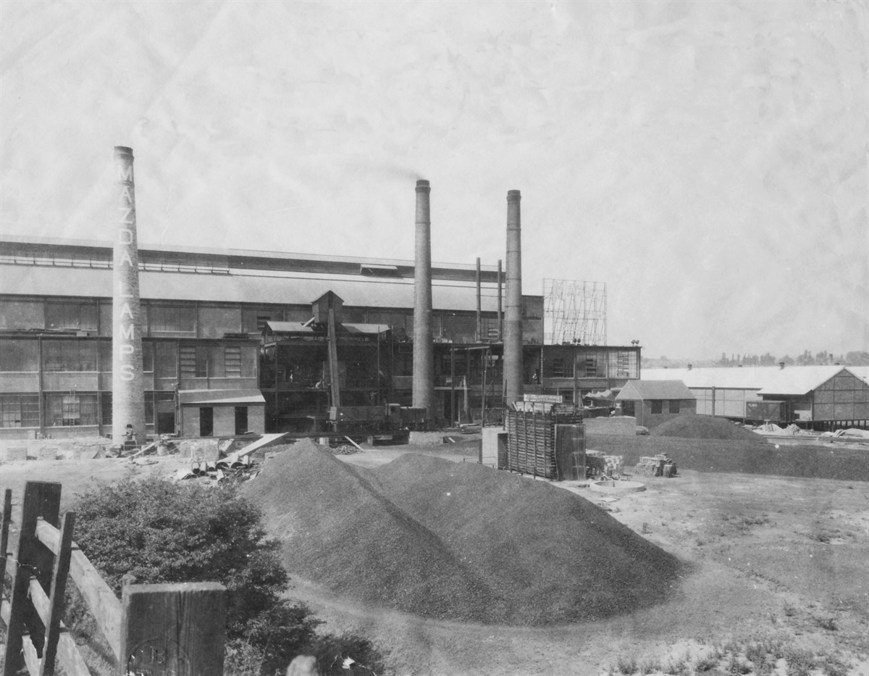
Coal piles in the yard at Chesterfield Glassworks used to generate gas.
A Touch of Glass
From the 1970s onwards Chesterfield’s glassmaking continued to go from strength to strength. Dema Glass became one of the leading glassware suppliers in the country, producing up to 100 million glasses a year by 1985.
It was a time, however, of change and takeovers. In 1971 Dema Glass became part of the Crown House Group (retaining its name) while Glass Tubes and Components was renamed Glass Bulbs Ltd as part of a merger with that company in 1978.
Dema was taken over for a second time in 1987 by furnishing retailer, Coloroll. This time ‘Dema’ simply became a brand name. Yet despite expansion and successful sales, the collapse of Coloroll in 1989 gave an uncertain future. Neighbouring G B Glass, who supplied the glasses to Dema, bought the company out, renaming the division Dema International.
In 1995 G B Glass transferred the manufacture of all light bulbs and tubes to its factory in Harworth and concentrated on producing glassware. The following year, the company was renamed Dema Glass with Chesterfield representing the tableware division. Despite lucrative contracts with Virgin Atlantic and the Ministry of Defence, Dema Glass went into receivership in 2000. The factory closed in 2001.

By 1994 Dema was supplying three fifths of the glasses used in British pubs and restaurants. Customers included Whitbread, Bass, Courage and Trust House Forte. Dema were also Britain’s largest exporter of glassware. Their speciality was Weizenbier glasses for the German market (pictured above).
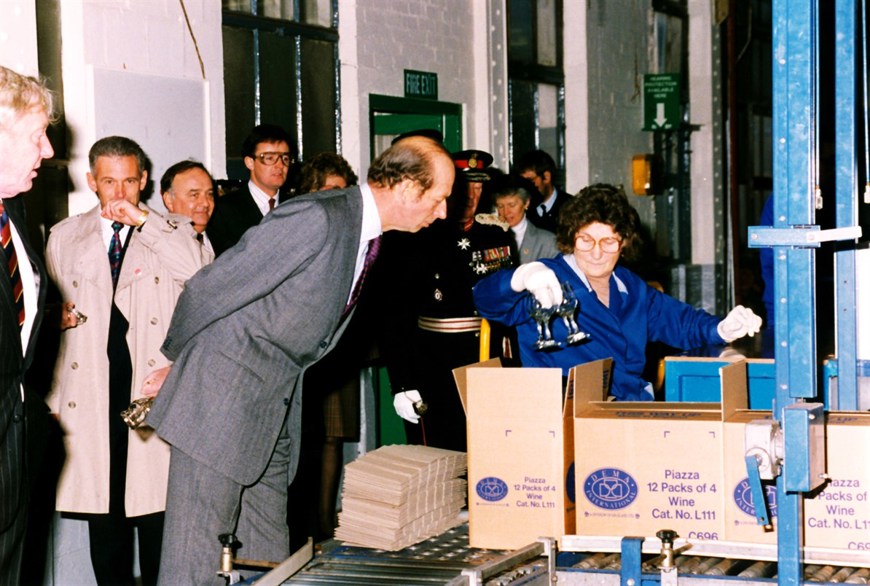
Pictured above - The Duke of Kent visited Dema in 1992 in his capacity as the Chair of the Overseas Trade Board. The visit was in recognition of GB Glass Engineering’s achievement of the Queen’s Award for Industry.

One of Dema’s major selling points was their ability to work with customers to produce glasses to their exact specifications. The company were also able to offer personalised and branded decoration, much of which was done by hand using silk screen and transfer badge methods, like the picture above.